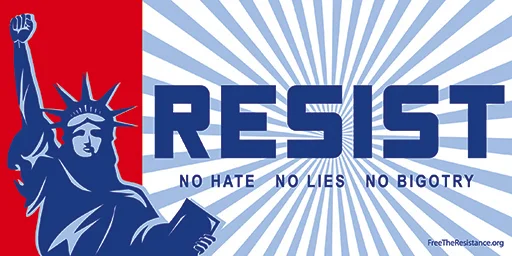What is the Resistance? Part IV: What's Next? By Eric van der Vort
Earlier in this series, I argued the Resistance is having a large impact and has a particular set of strengths and weaknesses. In this installment, I ask what is next for the Resistance? It has had six months of successful organizing. Can the Resistance keep its focus and its energy? I think the answer is a resounding “yes,” but with provisos that will make some parts of the Resistance uncomfortable.
I treat the Resistance as a social movement. This approach is debatable, but given the Resistance’s breadth and diversity, I believe scholars should approach the Resistance as a social movement with a highly fluid and evolving organizational field. Social movements follow a general lifecycle of emergence, coalescence, centralization, and decline. Each movement is different, but this lifecycle pattern can give us some insight into the possible futures of the Resistance.
Using this framework, where should we locate the Resistance? We are well past emergence. The 2016 election was the spark for emergency activism. There are many ways to track this. In the weeks after the election, spontaneous protests occurred across the country.
A group of former Congressional staffers wrote a document called the Indivisible Guide laying out a strategy for resisting Republican control of the federal government using Tea Party tactics. New groups emerged, organized nationally and in small groups of citizens meeting in their homes.
These emergent elements laid the foundation for the Resistance. These elements then coalesced around the Women’s Marches. As Inauguration Day came and went, groups around the country came together to stage the Women’s Marches, and then a science march, and a climate change march, and many other actions. These prominent events attracted citizen-activists and helped to bring the Resistance together.
Therefore, the Resistance has emerged and coalesced. Where will coalescing lead? How will it centralize? To answer this question, I focus on one large chunk of the Resistance: Indivisible.
Indivisible began as a widely circulated Google Doc called the Indivisible Guide. That guide has grown into a 501(c)4 organization with around 5,800 loosely affiliated chapters nationwide.
Indivisible’s stated mission is to "defeat the Trump agenda, elect progressive leaders, and realize bold progressive policies.” They currently provide policy information and strategic guidance to their chapters in collaboration with partner groups. They are preparing to provide electoral tools like voter registries and GOTV planning.
From January to July, Indivisible has grown from an idea to a major force in progressive politics. Other Resistance groups are following Indivisible’s path in ways that suggest the Resistance’s future growth and what will happen as it centralizes.
I suspect two things will happen as the Resistance matures. First, the plethora of groups operating at every level will begin to merge. Is it sustainable to have 5,800 chapters of Indivisible? Is it necessary to have multiple groups encouraging women, scientists, and Millenials to run for office? Is it advisable to have (as we do in Syracuse, NY) multiple local groups laying claim to the mantle of progressive politics? The evidence is mixed.
Scholars make a convincing case that organizational diversity allows social movements to be more effective at representing constituencies and responding to political events. On the other hand, too much diversity and competition can be harmful to a movement.
Out of sheer organizational necessity, many of these organizations will merge or fall apart. The TrumpCare debate arguably served as a focusing lens. Areas with many Indivisibles saw some of their chapters take on greater leadership or form “councils” of groups. These larger chapters will likely carry the mantle and assume greater prominence going forward. This is clear evidence of centralization.
Second, the Resistance will more openly affiliate with the Democratic Party. As I note in other posts, the Resistance comprises a large swath of American politics: mainstream Democrats, Greens, and Democratic Socialists all sit within its broad organizational field. As we move into electoral season, office-seekers are already drawing on the Resistance for time, energy, and money – and some participants are becoming candidates. Very few of those are running on GOP lines.
Democrats are capitalizing on the Resistance, a fact that will dissuade some of its activists. Driven as it is by anti-Trump activism, I think the Resistance will be hard-pressed to maintain a veneer of nonpartisanship. This revolution, at least, will be Democratic to its core. As the Resistance and Democrats align openly, we can read this as more centralization.
Eric van der Vort is a Ph.D. candidate in Political Science at The Maxwell School of Syracuse University.





